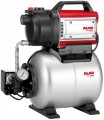Maximum performance
The maximum volume of water that the device can pump in a certain amount of time. It is one of the key specs of any pump because characterizes the volume of water with which the device can work. At the same time, it does not always make sense to pursue maximum performance — after all, it significantly affects the dimensions and weight of the unit.
Some formulas allow you to derive optimal performance values for different situations. So, if the pump is designed to supply water to water intake points, its minimum required performance should not be lower than the highest total flow rate; if desired, a margin of 20-30% can be added to this value. And for sewer models (see "Suitable for"), everything will depend on the volume of wastewater. More detailed recommendations for choosing a pump depending on performance can be found in special sources.
Maximum head
The maximum head generated by the pump. This parameter is most often indicated in meters, by the height of the water column that the unit can create — in other words, by the height to which it can supply water. You can estimate the pressure created by the pump using a simple formula: every 10 m of head corresponds to a pressure of 1 bar.
It is worth choosing a pump according to this parameter, taking into account the height to which it should supply water, as well as adjusting for losses and the need for pressure in the water supply. To do this, it is necessary to determine the difference in height between the water level and the highest point of water intake, add another 10 to 30 m to this figure (depending on the pressure that needs to be obtained in the water supply), and multiply the result by 1.1 — this will be the minimum pressure required.
Max. pressure
The highest pressure that the pump is capable of creating during operation. This parameter is directly related to the maximum head (see above); however, it is less obvious, and therefore, it is indicated rarely.
Maximum liquid temperature
The highest temperature of water at which the pump is capable of operating normally. Usually, in most models this parameter is 35-40 °C — at high temperatures it is difficult to ensure effective cooling of the engine and moving parts, and in fact, such conditions are rare.
Dry run protection
A system that protects the unit from running without water.
The dry running mode is abnormal for any pump: at best, the mechanism of the unit in this mode experiences increased loads, and at worst, the device may fail and even a serious accident. This feature allows you to prevent such consequences. The specific method of protection against dry running may be different; one of the most popular options is a float switch (see below). However, in addition, flow sensors, pressure or level switches can be used. These details depend both on the general type of pump and on the specific model; they should be specified separately in each case.
Volume of water pressure tank
The volume of the water pressure tank provided in the design of the pressure tank unit.
A water pressure tank is a reservoir capable of holding a certain volume of water. It performs several functions at once. The main ones are: firstly, maintaining a stable pressure; secondly, protection against water hammer; and thirdly, storage of an “emergency” supply of water in case of a power outage, pump breakdown, etc. The larger the volume of this tank, the better it handles its capabilities; on the other hand, a large capacity significantly affects the dimensions and cost of the tank. Therefore, it does not always make sense to look for a pump with the maximum volume of the water pressure tank. Specific recommendations on choosing the optimal volume for different situations can be found in special sources.
Maximum power
Rated power of the pump motor. The more powerful the engine, the higher the performance of the unit, usually, the greater the pressure, suction height, etc. Of course, these parameters largely depend on other features (primarily the pump type, see above); but models similar in design can be compared in terms of power.
Note that high power, usually, increases the size, weight and cost of the pump, and also implies high costs of electricity or fuel (see "Power source"). Therefore, it is worth choosing a pump according to this parameter taking into account the specific situation; more detailed recommendations can be found in special sources.
Power cord length
The length of the cable that supplies electricity to the pump with the appropriate type of power supply (see above). The longer the cable the farther from the socket or other power source you can install the pump. This parameter is especially important for submersible models: if the cable is too short, it will simply be impossible to lower the pump to the maximum depth provided for by its design, because ordinary extension cords cannot be immersed in water.
Noise level
The noise level produced by the pump during normal operation. For comparison, 50 decibels roughly corresponds to the noise in an office room, 60 dB to an average TV volume, 70 dB to a truck at a distance of about 8 m, 80 dB to traffic noise, and 90 dB to a scream. The lower the noise level, the more comfortable the use of the pump and the closer it can be placed to people. This parameter is especially important for models designed for indoor installation.

